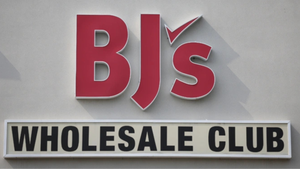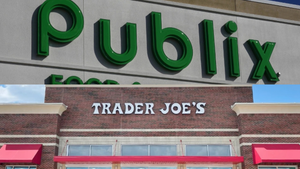Online sales to near 14% of U.S. grocery market in next five years
Increased traction for pickup to help drive almost 12% annual growth for e-grocery sales, Brick Meets Click forecasts.

Despite a letup since the peak of the pandemic, U.S. online grocery sales stand to maintain a strong annual growth pace over the next five years, fueled in part by rising use of pickup service, strategic advisory firm Brick Meets Click projects.
E-grocery sales are expected to swell from 11.2% of the overall U.S. grocery market in 2022 to a 13.6% share in 2027, according to the 2023 Brick Meets Click/Mercatus 5-Year Grocery Sales Forecast, released Monday. The estimate reckons an 11.7% compound annual growth rate (CAGR) for online grocery sales during the five-year period.
Meanwhile, total U.S. grocery sales—including in-store and online—look to grow at a 2.5% CAGR through 2027, excluding the impact of price inflation, Brick Meets Click reported. Driving that trend will be a roughly 1.7% gain in household spending and a 0.8% uptick in the number of households.
Within e-grocery, pickup sales will grow at an estimated five-year CAGR of 13.6%, outpacing growth rates of 10.8% for delivery and 8% for ship-to-home. That CAGR will fatten click-and-collect’s share of online grocery sales from 45.4% in 2022 to a projected 50.3% in 2027 as pickup siphons sales from the other two channels.
Barrington, Illinois-based Brick Meets Click cited ongoing inflation; lingering concerns about illnesses such as COVID-19, RSV and the flu; and a maturing online segment as key factors behind its five-year online grocery sales outlook. Similarly, an aging population and shrinking household size are encumbering growth in the overall grocery market.
“This forecast reflects that the projected growth of online grocery sales is slowing after the significant gains of the last two-plus years,” explained David Bishop, partner at Brick Meets Click, which examines the impact of digital technology on food sales and marketing. “Now more than ever, grocers need a grounded view of the future market while simultaneously strengthening the customer experience to protect their base business and improving the profitability of this higher cost-to-serve mode of shopping.”

Source: Brick Meets Click
Consumers will continue to tangle with elevated inflation over part of the five-year forecast period. Brick Meets Click anticipates grocery-related inflation to average 4.8% over that time span, starting at 10.9% in 2022 and sliding down to 2.8% in 2027. The advisory firm noted that inflation will drive nearly 75% of the projected gains for in-store sales but less than half of the gains estimated for online sales.
To a certain degree, health concerns remain an online grocery motivator as consumers seek contactless ways to shop for food, and it’s not just due to COVID, Brick Meets Click said. The October 2022 Brick Meets Click/Mercatus Grocery Shopping Survey found that about 10% of online grocery monthly active users (MAUs) used e-grocery services to help prevent COVID infection. Such concern also spread to other respiratory illnesses like RSV and seasonal flu in the latter part of 2022 as cases mounted and pushed customers to shop online for groceries.
Expected increases in market availability likely will expand pickup more than delivery or ship-to-home. Brick Meets Click noted that some U.S. households still lack convenient access to click-and-collect, and many grocery retailers are still rolling out pickup services across their stores. The advisory firm described the grocery delivery space as “already saturated” since most consumers can choose from multiple home delivery options across a wide range of retail banners. Delivery, too, is more sensitive than pickup to financial (fees) and health concerns (interacting with delivery personnel).
Through 2027, average order values (AOVs) are forecast to grow at a 4.2% to 6.4% CAGR, including inflation. Growth for pickup will be in the higher end of that range, with delivery falling in the middle and ship-to-home on the lower end. Order frequency among active users is expected to rise from 1.9% to 3.3% over the five years, with the same growth-rate breakout among the three fulfillment channels.
In working toward online profitability over the coming five years, grocery retailers should “focus on the fundamentals, according to Sylvain Perrier, president and CEO of Toronto-based e-grocery solution specialist Mercatus.
“Know who your customers are and the value you provide them. Use that insight to deliver a more personalized brand experience that is consistent and frictionless,” Perrier stated. “Take steps to improve margins using simple tactics like offering lower-cost pickup services, engaging with multiple third-party delivery providers and leveraging first-party retail media to offset the cost to serve online customers.”
The 2023 Brick Meets Click/Mercatus 5-Year Grocery Sales Forecast is based on a proprietary model that leverages Brick Meets Click research and insights plus secondary sources from various government agencies. The analysis defines online grocery channels for delivery as retailer and third-party services (e.g. Instacart, DoorDash, Shipt), while pickup includes in-store, curbside, locker and drive-up services. Ship-to-home sales cover online grocery purchases delivered by parcel couriers like Federal Express, UPS and the U.S. Postal Service.
About the Author
You May Also Like






